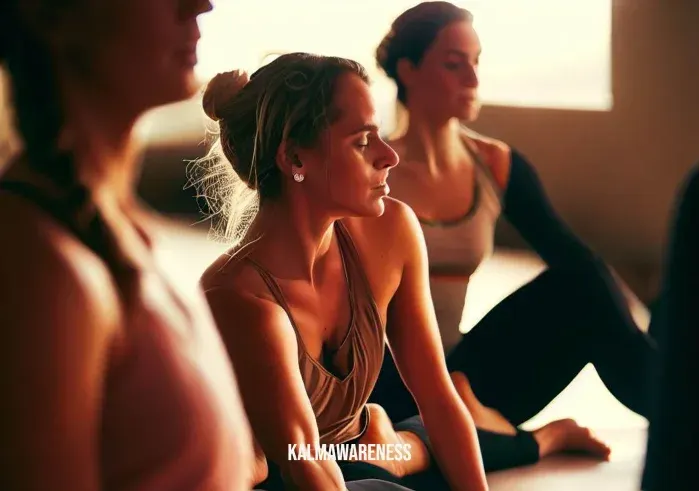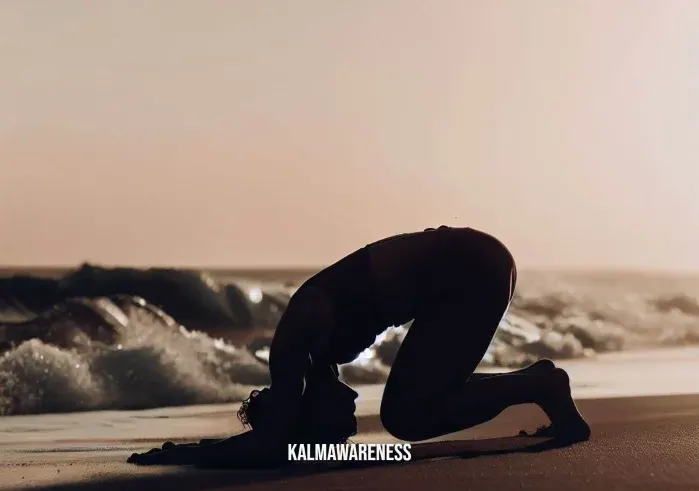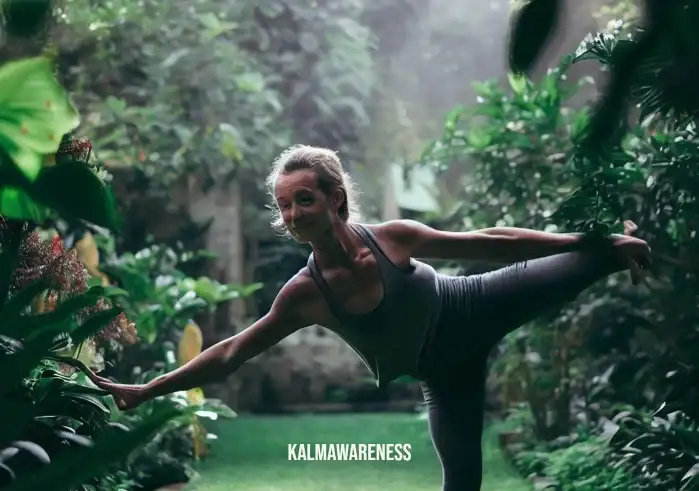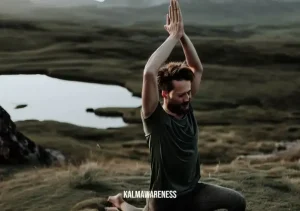Yoga Pose: Exploring the Side Crow Pose
| Description | Explanation |
|---|---|
| Pose Name | Side Crow Pose |
| Original Name | Parsva Bakasana |
| Difficulty Level | Intermediate |
| Pose Category | Arm Balances |
| Exercise Duration | Varies based on proficiency |
The Side Crow Pose, also known as Parsva Bakasana, is an invigorating arm balance that challenges both strength and balance. It requires a combination of core engagement, upper body strength, and focus. This intermediate-level pose is often included in yoga practices to enhance body awareness and cultivate mental concentration.
Duration:
The recommended amount of time to hold the Side Crow Pose varies depending on your level of experience and comfort. For beginners, start with holding the pose for about 10-15 seconds, gradually increasing the duration as you gain strength and stability. Advanced practitioners can aim for holding the pose for 30 seconds to 1 minute or longer.
Step-by-Step Guide:
- Begin in a standing position at the front of your mat, feet hip-width apart. Take a few moments to ground yourself, align your body, and establish a steady breath.
- Bend your knees and come into a squatting position, keeping your feet close together. Bring your hands down to the mat in front of you, shoulder-width apart, fingers spread wide.
- Shift your weight onto your hands and start to lean forward. Place your upper arms against the outside of your knees, just above the elbows. This will create a secure foundation for the arm balance.
- Slowly begin to shift your weight onto your hands, engaging your core muscles for stability. Lift your hips as you lean forward, bringing your knees closer to your upper arms.
- As you feel more balanced and stable, start to lift one foot off the ground, pressing the corresponding knee into the outside of the opposite upper arm. Keep your gaze focused on a fixed point to maintain your balance.
- With control and strength, continue to shift your weight forward and lift the other foot off the ground. Both knees should be pressing into the upper arms, and your body weight should be centered over your hands.
- Find your balance in the Side Crow Pose, maintaining a strong core and engaged muscles throughout your body. Keep breathing steadily and relax your facial muscles.
- To release the pose, slowly lower one foot back to the ground, followed by the other foot. Return to the squatting position, and then stand up straight, allowing yourself a moment to integrate the experience.
What’s Next?
Congratulations on completing the first part of our exploration of the Side Crow Pose! In the next section, we will delve deeper into the benefits of this pose for the body and mind. We will also explore variations and modifications that can help you progress in your practice.
Remember, practice with patience and listen to your body. Enjoy the process and embrace the transformative power of yoga.

Exploring the Side Crow Pose: Benefits, Modifications, and Considerations
In the previous section, we learned about the Side Crow Pose, its step-by-step instructions, and the foundational aspects of this invigorating arm balance. Now, let’s delve deeper into the benefits of the pose, explore variations suitable for different levels of experience, and discuss who should approach this pose with caution.
Benefits of the Side Crow Pose:
- Core Strength: The Side Crow Pose is an excellent way to strengthen your core muscles, including the abdominal and oblique muscles. The twisting motion and balance required in this pose engage and tone these muscle groups.
- Arm and Shoulder Strength: As you support your body weight on your hands, the Side Crow Pose strengthens your arms, wrists, and shoulders. Regular practice can increase upper body strength and stability.
- Improved Balance: Balancing on your hands while twisting challenges your sense of balance and proprioception. With consistent practice, you can enhance your overall balance and body awareness.
- Concentration and Mental Focus: The Side Crow Pose demands mental concentration and focus to maintain stability and balance. As you engage in this challenging arm balance, you cultivate mindfulness and enhance your ability to stay present.
- Digestive Health: Twisting poses, like the Side Crow Pose, can stimulate digestion and aid in detoxification. The gentle compression and massage of the abdominal organs promote healthy digestion and can alleviate digestive discomfort.
Modifications and Variations:
Modifications and variations of the Side Crow Pose allow practitioners of different levels to experience its benefits and progress in their practice. Here are a few options:
- Supported Side Crow: For beginners or those working on building strength, using blocks or props can provide support and stability. Place a block between your thighs and rest your knees on the upper arms while attempting the pose. This modification helps you focus on the core engagement and balance before attempting the full pose.
- One-Legged Side Crow: Once you feel comfortable with the basic Side Crow Pose, you can challenge yourself further by lifting one leg while in the pose. This variation increases the demand on your core and adds an element of balance.
- Extended Side Crow: To intensify the pose and target your oblique muscles, try extending one leg straight out to the side while balancing in the Side Crow Pose. This variation requires increased core strength and flexibility.
- Advanced Transitions: Once you have mastered the Side Crow Pose, you can explore transitioning in and out of the pose with fluidity. Experiment with moving from Side Crow Pose to other arm balances or incorporating it into a flowing sequence.
Considerations and Precautions:
While the Side Crow Pose offers numerous benefits, it may not be suitable for everyone. Here are some considerations:
- Wrist or Shoulder Injuries: If you have a history of wrist or shoulder injuries, it is advisable to approach the Side Crow Pose with caution or seek guidance from a qualified yoga instructor. Modify or avoid the pose if it causes discomfort or pain.
- Pregnancy: Pregnant individuals should avoid deep twists and inversions like the Side Crow Pose. It’s important to prioritize the well-being of both the mother and the baby during this special time.
- Recent Abdominal Surgery: If you have undergone recent abdominal surgery or have any abdominal conditions, consult your healthcare provider or a knowledgeable yoga instructor before attempting the Side Crow Pose.
Remember, yoga is a personal journey, and it’s essential to honor your body’s limitations and listen to its signals. If you encounter any discomfort or pain during the pose, ease out of it gently and seek guidance from a qualified professional.
Next Steps:
We have explored the benefits, modifications, and considerations of the Side Crow Pose. In the next part of our article, we will dive into the history and philosophy behind this pose, as well as its connections to the broader world of yoga.
Continue to challenge yourself, embrace the joy of exploration, and remember to always listen to your body.

Unveiling the Side Crow Pose: History, Spiritual Significance, and Tips for Mastery
Welcome to the third part of our exploration of the Side Crow Pose in yoga. In this chapter, we will embark on a journey through the historical roots of this pose, discover its spiritual significance, uncover valuable tips for maximizing its benefits, explore common mistakes to avoid, and delve into complementary poses. Let’s dive in!
The History of the Side Crow Pose:
The Side Crow Pose, or Parsva Bakasana, has its origins in the ancient practice of yoga. While precise historical documentation is challenging, the pose has been passed down through generations of yogis, embodying strength, balance, and focus. It has been mentioned in ancient texts like the Hatha Yoga Pradipika and the Gheranda Samhita, providing insights into its historical significance within the yogic tradition.
The Spiritual Significance of the Side Crow Pose:
Beyond its physical benefits, the Side Crow Pose carries symbolic meaning within the realm of spirituality. As you balance on your hands, twisting your body, and defying gravity, the pose represents the harmonization of opposing forces. It signifies finding balance amidst the challenges and uncertainties of life. The pose encourages the practitioner to cultivate determination, discipline, and mental focus—essential qualities for progressing on the spiritual path.
Tips for Getting the Most Out of the Side Crow Pose:
To enhance your experience and progress in your practice of the Side Crow Pose, consider the following tips:
- Warm-up: Engage in a thorough warm-up routine before attempting the pose. Pay particular attention to stretching and activating the wrists, shoulders, core, and hips to prepare your body for the demands of the pose.
- Engage the Core: Strong core engagement is crucial in the Side Crow Pose. Focus on drawing your navel towards your spine and activating the abdominal muscles to maintain stability and control throughout the pose.
- Find Your Drishti: Drishti refers to the focal point for concentration during a yoga pose. Fixing your gaze on a steady point in front of you helps improve balance and concentration in the Side Crow Pose.
- Breathe Mindfully: Maintain a steady and controlled breath throughout the pose. Deep, even breathing helps calm the mind, center your focus, and create a sense of ease while in the challenging posture.
Common Mistakes to Avoid:
To ensure safe and effective practice, be mindful of these common mistakes and avoid them:
- Collapsing Shoulders: Avoid sinking into your shoulders or allowing them to round forward. Instead, actively engage and draw your shoulder blades down and back, creating stability and openness in the upper body.
- Lack of Core Activation: Neglecting to engage the core can compromise the integrity of the pose. Keep your core muscles actively involved to support your body weight and maintain balance.
- Placing Too Much Weight on the Wrists: Distribute your weight evenly between your hands and avoid excessive pressure on your wrists. Engage the muscles in your arms and shoulders to share the load and protect your wrists.
Modifications for People with Injuries or Limited Flexibility:
Every body is unique, and modifications can make the Side Crow Pose accessible to individuals with injuries or limited flexibility. Consider the following options:
- Block Support: Place a block or folded blanket under your feet to elevate the ground and provide additional support while you build strength and confidence in the pose.
- Knee-to-Arm Variation: Instead of balancing on your upper arms, rest your knees on the outside of your upper arms, allowing for a modified version of the Side Crow Pose that reduces strain on the wrists and shoulders.
Poses Complementary to the Side Crow Pose:
To deepen your practice and explore further possibilities, incorporate the following poses that complement the Side Crow Pose:
- Crow Pose (Bakasana): Crow Pose serves as an excellent preparatory pose for the Side Crow Pose. It strengthens the arms, wrists, and core while building confidence in arm balances.
- Twisting Poses: Poses like Revolved Triangle (Parivrtta Trikonasana) and Revolved Chair Pose (Parivrtta Utkatasana) provide an opportunity to further explore the twisting aspect of the Side Crow Pose, enhancing spinal mobility and balance.
Next Steps:
Congratulations on delving into the history, spirituality, tips, and modifications for the Side Crow Pose! In the final part of our article, we will conclude our exploration by summarizing the key takeaways, emphasizing the importance of regular practice, and inspiring you to embrace the transformative power of this pose.
Remember, the practice of yoga is an ever-evolving journey, and each pose offers unique insights and benefits. Embrace the challenges, approach the practice with an open heart and mind, and trust in your own inner strength.





